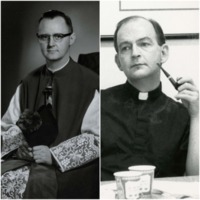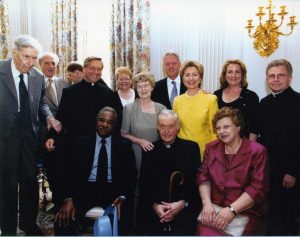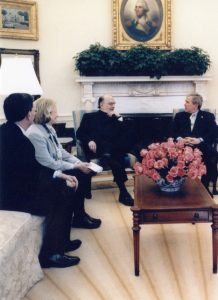
In 1986, Monsignor George Higgins wrote to his friend, Richard John Neuhaus, that it “would appear that we will simply have to agree to disagree agreeably about your report on the Synod,”¹ referring to their differing views of the 1985 Synod assessing Vatican II reforms. Theologian David Bentley Hart noted in 2006 that Neuhaus was “opinionated (definitely), but not at all spiteful or resentful towards those who disagree with him.”² Both priests were very active in public life, both held strong opinions about politics and religion, and neither stopped communicating with each other despite their differing views on the major issues of the day. Our new American Catholic History Classroom website explores the relationship between the two priests in the context of the times in which they lived.
Higgins was the older of the two men, born in 1916 in Chicago, and educated for the priesthood from his teenage years. He graduated from and eventually came to teach economics at The Catholic University of America, while serving as director of the Social Action Department, and later as Secretary for Research then Secretary for Special Concerns for what is today called the U.S. Conference of Catholic Bishops. Known as a “labor priest,” Higgins is most notable for his work representing the Bishops’ Conference on matters related to organized labor and interfaith relations. His work with Cesar Chavez and the United Farm Workers of America, as well as his work as a labor mediator in a variety of other labor-employer disputes is well known, and you can read more about those activities here on our website on Higgins, the Bishops, and the United Farm Workers of America.

Neuhaus, born in 1936, spent many of his years as a young Lutheran pastor working in anti-war and pro-civil rights work before embracing more conservative religious views in the late 1970s, when he became increasingly critical of what he saw as mainline Protestant Christianity’s accommodation to American secular liberal politics. After the publication of his book The Naked Public Square: Religion and Democracy in America in 1984, Neuhaus became an increasingly influential conservative thinker on matters related to the intersection of religion and politics. By 1990, he decided to convert to Catholicism, and in 1991 he was ordained a priest. Increasingly associated with the conservative thought of his friends George Weigel and Michael Novak, Neuhaus was sought after by nationally prominent political conservatives by the late 1990s, advising individuals such as George W. Bush on how to address matters such as abortion and military engagement from a religious perspective.

Higgins and Neuhaus disagreed on the meanings of a variety of Catholic teachings related to the economy, politics, and labor unions. They never stopped corresponding when both were alive, however, and their dialogue offers a window into how two different Catholic public figures viewed the same world during their time.
View the finding aid to the George G. Higgins Papers.
View the finding aid to the Richard John Neuhaus Papers.
¹ George Higgins to Richard Neuhaus, April 26, 1986, Higgins Papers, American Catholic History Research center and University Archives, The Catholic University of America.
² David Bentley Hart, “Con Man,” The New Criterion, September 2006, retrieved 8/27/18: https://www.newcriterion.com/issues/2006/9/con-man
